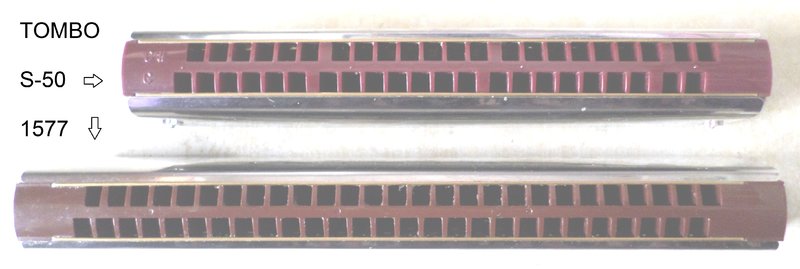Sorry for the stubbed content of the link from January 2019 to the German harp forum. But if a user withdraws his pictures and videos from the picture hoster or cancels his account, the pics wil not be visible in the respective forum any more. This is out of my control. When I posted the link they were still visible.Malarz wrote: ↑Fri May 08, 2020 7:00 pm Triona,
Is the Tombo No. 1577 out of production? The S50 still is available but not in the US. (Shipping available to the US, though.) I tried to look at the link you provided comparing the 1577 and S50 but besides being in German (!), the image was no longer available. Can you summarize the differences? Are there notation charts available to be able to compare both?
Here some pics of those harmonicas:
http://www.tombo-m.co.jp/harmonica/index.html
If you scroll down to the bottom of the page, you can see that both instruments are still shown on Tombo's japanese website. Since new there is added: 販売終了いたしました。= sale has stopped = discontinued. Tombo's English website does not show the 1577 any more since longer. I don't know whether there are some remains available on the market. At least maybe some used ones.
All the German and some British dealers I checked do not offer the 1577 any more, including amazon and the one which I bought mine from.
Here it is still listed as available: https://www.crafton.se/sv/artiklar/1577.html
(It seems to be one of the main importers in Sweden.)
At Rakuten in Japan (a shopping platform) it is still listed sometimes as well.
About US I don't know anything.
Here pics and note layout again (from my own pic hoster):

The pic shows the corresponding notes above each other.
On both of them he lower row of holes gives the C scale, the upper row gives the C# scale. The harmonica has to be tilted in the mouth to change from naturals to accidentals.


blasen = blow, ziehen = draw
Both have in common:
Coverplates also cover the back of the harmonica > no hand vibrato possible.
One reed in each channel > no interactive bending possible, good single reed bending.
Double C's and F's (enantonics), each one in upper and lower row.
Brass reeds, plastic comb, made in China.
Nice sound, reasonable volume, easy response OOTB, reasonable value for a good price.
Cheap plastic box / zipper envelope, smelling heavily of chemicals.
Differences:
S-50 beginning with C4, 1577 beginning with G3.
S-50 has offset holes between the octaves on the comb.
hope that will do now
dear greetings
triona
